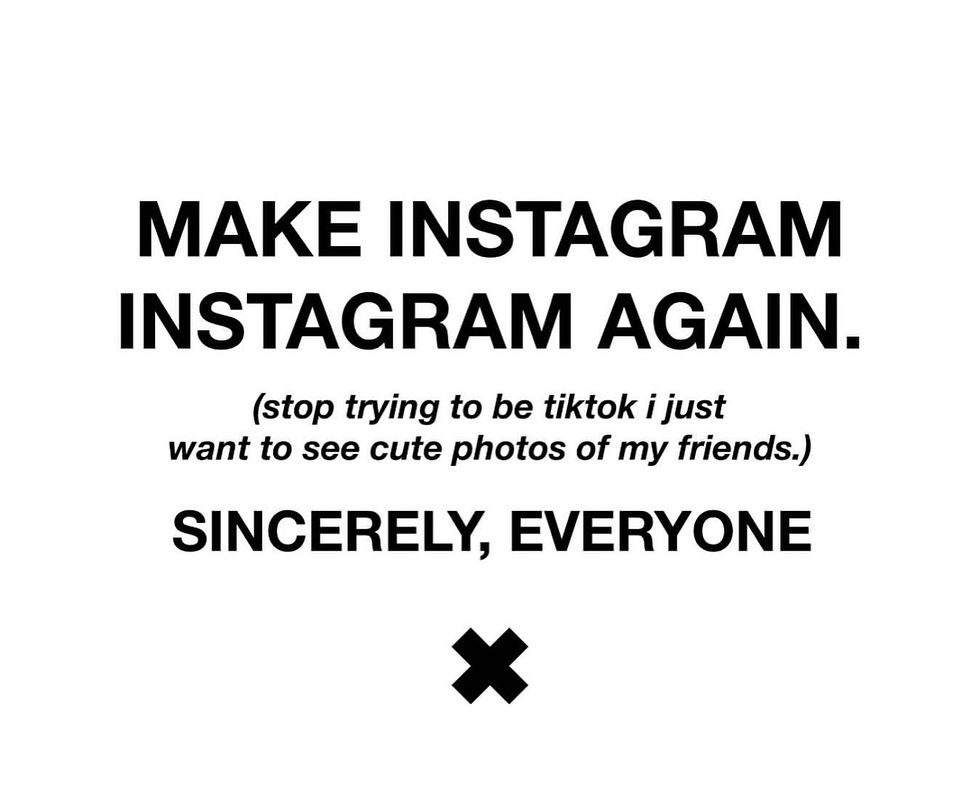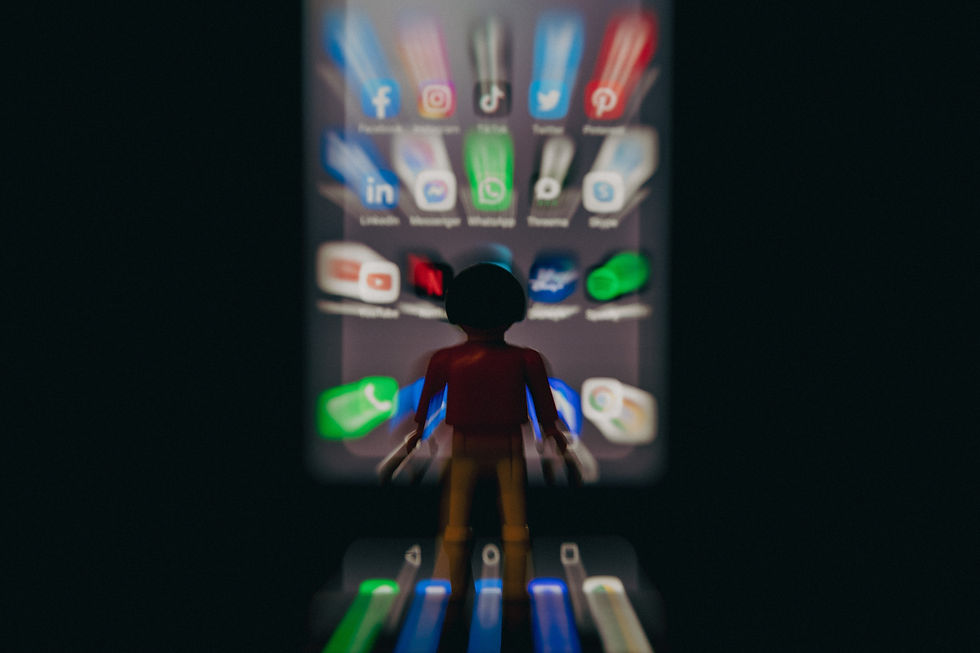TikTok? I hope not.
- Katie Brockhurst

- Aug 27, 2022
- 6 min read
Last month Instagram tested out some changes to the look and feel of their timeline, essentially copying TikTok, in an attempt to vie for more of our attention. I was one of many who received the update, it was interesting to see, but it was not for me!
Instead of my slow infinite scroll, filled with photos of friends, affirmations, and thoughtful captions or Reels, my newsfeed had become a full-screen video experience, which felt like it was shouting at me the second I opened the app, as I swiped quickly past each person, akin to some kind of entertainment Tinder.
Gone was the more peaceful, quieter Instagram experience we know and love (well love/hate).
Whilst other social media platforms push noisy video over still photos, Instagram has always gone the other way – and for its slightly older users, who love gazing upon beautiful photos of food and gardens in bloom, it’s worked. Sunsets may not be everybody’s cup of tea, but in an increasingly noisy and frenetic online world, the Instagram experience has always seemed like a sea of tranquillity compared with Facebook, Twitter, TikTok and Snapchat.
~ Bryony Gordon, 'I’m going to sit still and enjoy the silence – and you should join me', The Telegraph
I panicked for a moment, starting to rethink how we, my clients and comrades in this social media space, would now have to create content for Instagram. The videos filled the entire screen, leaving little to no room for text underneath. The second I opened the app, the audio played automatically, instead of being on mute by default. I had to turn down the volume on my phone to make it Shhhhh. My nervous system seized up – this new version of Instagram felt claustrophobic, as there was no space around the posts to breathe, the content felt in my face, and almost invasive.
Thankfully I wasn’t the only one who felt displeasure over these changes. Artist Tati Bruening created a meme saying, ‘Make Instagram Instagram Again’, which was re-shared by tens of thousands of users, including various Kardashians.

Bruening created a petition to roll back the changes, which at the time of writing had over 300,000 signatures. Content creators everywhere cried out, leading to Instagram head Adam Mosseri posting a response, somewhat patronisingly explaining that Instagram needs to move with the times, and while they would continue to support photos, it was clear that Meta felt that short-form video content is the future. Basically, he was saying, ‘This is how things are going to be from now on – get used to it.
Then people power, the hive mind actually made a difference here!! The results were in and engagement was down. The machine, the AI, it learns and iterates from our actions and Meta ultimately decided to pull the plug on these changes.
Adam Mosseri explained, ‘I’m glad we took a risk – if we’re not failing every once in a while, we’re not thinking big enough or bold enough. But we definitely need to take a big step back and regroup.’
So it seems Instagram is safe… for now. (Except for the 30% suggested content Zuck promised to invade our timelines by the end of next year, but we can change the tide of this too, but that is a topic for another time…)
When the app went back to normal, my (and the Instagram populations) body went, ‘Ahhhhhh’.
There was space to breathe again.
I can only hope that Instagram doesn’t keep trying to turn into TikTok. Because, to be honest, I don’t want to do TikTok.
A few months back, I gave it try, I mean I have to see don’t I? I work in the world of social media, and I had put it off for so long. It did suck me into a dopamine driven swipey vortex for about a week. Thankfully I haven’t had the desire to go back.
So Instagram as TikTok? I really do hope not, and it is a no from me on a personal level, even though I am considering it professionally with clients. And this isn’t just me being irritated by pointless (and sometimes dangerous) TikTok trends – I believe that TikTok is legitimately dangerous for a number of reasons.
Firstly, TikTok is owned in part by the Chinese Communist Party, who ergo have access to all your data and are tracking a lot of you do online? The reason TikTok is so good at recommending videos is because its algorithm is Facebook’s circa 5 years ago before they had their hands slapped and regulations brought in as to what they do with your data.
Secondly, aside from political regimes blatant data-harvesting, I believe that TikTok has the potential to damage our collective mental health in the long term too. The long-term effects of constant consumption of short-form video is yet to really be seen, but we could be numbing the ability of a whole generation to do deep thinking and be creative.
This type of content reduces attention spans. We’ve all been there, surely? And we know it is happening. I’m sure it happens to you too, you open your phone and the next thing you know, an hour has gone by.
An article about a study done with Chinese college students even calls it ‘Short-form Video Addiction’ (SVA). The study also states that there is a direct link between perceived stress and short-form video applications. The article goes on to say, ‘Research suggests that short-form video application addiction (SVA) may be another subcategory of Internet addiction and could cause negative influences on individuals’ adaptation and well-being.’
It obviously isn’t healthy for us to be exposed so much to this sort of content. And I fear especially for children growing up with this type of content constantly in their faces. Social media is a minefield already, let alone the hazards posed by apps like TikTok. This isn’t even factoring in the potential dangers of various online challenges, which seem to thrive on TikTok, and have lead to multiple deaths.
You may have heard the heartbreaking story of Archie Battersbee in the UK, who was taken off life support earlier this month. While the majority of the mainstream media news coverage has been focused on the court case to keep him on life support, I’m surprised more hasn’t been said about how Archie ended up there in the first place. It’s believed that he was taking place in a challenge doing the rounds on TikTok that involves kids choking themselves, known as the ‘blackout challenge’. This challenge first appeared on social back in 2008, with over 80 deaths attributed to it, and has re-surfaced again on TikTok in the last year. TikTok is currently being sued by a number of parents whose children were found asphyxiated, their phones showing that in the moments before their deaths, they had been viewing the blackout challenge on the app. When questioned, TikTok merely released a statement saying, 'This disturbing “challenge”, which people seem to learn about from sources other than TikTok, long predates our platform and has never been a TikTok trend. We remain vigilant in our commitment to user safety and would immediately remove related content if found.’
To conclude, without going too far down the rabbit hole, I feel it is safe to say that this company does not actually care about your wellbeing. I’ve heard some horror stories about people working for the company and how they treat their senior, female staff members, it is really not good.
In my last moon letter, I wrote about being the change from within, using social media to shine your light and spread your message, and I stand by that and by my clients who want to use TikTok to reach more people through it. It is important to be the light within, how else can we affect change?
I am currently working on systems and content strategies for TikTok that embraces the use of third party scheduling tools, to keep the team off the app, whilst staying in alignment energetically with the message my clients have to share, as a way to work within the space. To focus on sending good vibes and healing light into the endless attention abyss of this particular short form entertainment market place, particularly popular with younger audiences.

Do you use TikTok? (If not why?)
If you do, do you watch or create, or do both for the platform?
Are you aware of how much time you spend on there?
How does it make you feel?
I’d love to hear your thoughts!



Great article Katie! I've not used tiktok either as a creator or consumer, nor do I have intention of doing so. But equally I'm not and my target audience are not teenagers with time to waste on making silly videos. It's interesting that Facebook / Meta gets a bashing as a capitalist corporate giant but the criticism of a communist controlled propaganda tool gets far less mainstream media traction.